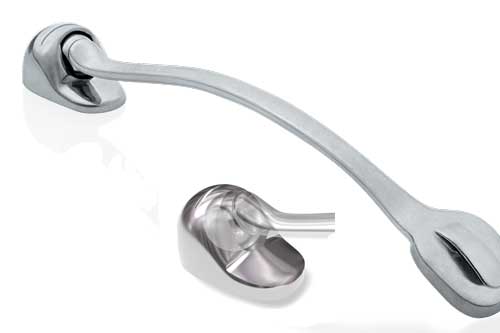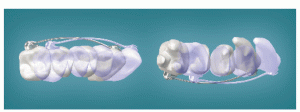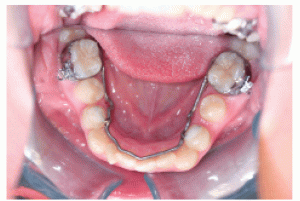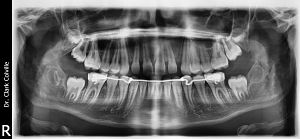The correction of Class II malocclusion remains one of the central issues that orthodontists face every day in their busy practices. With chapters in orthodontic textbooks devoted to explaining the etiology and treatment options used to correct these malocclusions, orthodontists are continually required to sift through a never-ending and always-expanding array of new approaches and appliances to determine what may work best for each individual patient to achieve the desired treatment goals.
After 10 years in the United States market, the Carriere Motion Appliance has become a staple for Class II correction in many orthodontic offices. The reason for this can be explained by looking closely at what I call The Five E’s. Let’s take look at each one of these for further explanation.
Effectiveness
The Carriere Motion Appliance has proven to be very effective in establishing a Class I platform early in treatment on a broad range of malocclusions requiring Class II correction, from minor rotation all the way through full step Class II molar correction. The ability to treat a broad range of Class II cases has made this the go-to appliance for Class II correction in our office.
The ball and socket feature is a key component (Figure 1). This feature allows a freedom of movement that is centered on the buccal surface of the first molar. When Class II elastics are applied to the cuspid, the force is indirectly translated to the molar at the ball and socket junction. This causes the molar to initially rotate to the distal much the same as simple tip back and rotation bend in a round stainless steel wire-—a basic movement in Class II correction (Figure 2).
Heavy Class II elastics are worn to move the entire buccal segment from the cuspid to the first molar in a distal direction. The recommended force levels are ¼-inch, 6.5 oz elastics. I have modified the elastic force to be a little gentler at the start of treatment by starting with a 5/16-inch, 4.0 oz elastic. After ?6 weeks we progress to a ¼-inch, 6.0 oz elastic for the remainder of the treatment.
While the desired result is distal movement of the buccal segment, secondary effects are also noted with heavy Class II elastic use. An evaluation of the force vectors would lead one to conclude that there should be a resultant vertical component on the maxillary cuspid and the mandibular molar. In addition, there should be an effect on the position of the lower incisor. This can vary depending upon the type of mandibular anchorage.
Using a temporary anchorage device in the lower arch to directly apply elastics will eliminate any dental changes in the lower arch-—maximum anchorage. A full-coverage Essix-type appliance in the lower arch will minimize the movement of the lower incisors. I have utilized a fixed lower lingual arch, incorporating additional anchorage from either the first bicuspids or the second molars as the primary anchorage device in the lower arch (Figure 3).

Clark D. Colville, DDS, MS, is a graduate of the University of Texas Health Science Center at Houston and maintains private orthodontic practices in Seguin and San Marcos, Tex. Colville is a Diplomate of the American Board of Orthodontics and is the President-Elect of the Southwestern Society of Orthodontists. In addition, he is an assistant clinical professor in the graduate orthodontic department at UT Houston and lectures frequently throughout the United States on Invisalign and the Carriere Motion Appliance.
A complete evaluation of the effects of the Carriere Motion Appliance would require a three-dimensional analysis using a combination of CBCT and intraoral scanning because dental changes are noted in three planes of space. To date, only limited information has been available, mostly individual case treatment reports.
Sagittal measurements from lateral cephalometric x-rays were examined in an unpublished study at the University of Illinois Chicago to determine some of the effects of the Carriere Motion Appliance. A paired t-test was performed to compare pretreatment cephalometric x-rays and similar x-rays taken at the time the appliance was removed—an average treatment time of 4.5 months. Significant values were reported for the upper incisors, lower incisors, and the upper cuspid. More importantly, there were no skeletal changes noted in either the mandibular plane angle, or the sagittal position of the maxilla, or the mandible in relation to the cranial base.
Distal movement of the upper incisors and cuspids is beneficial for Class II correction and overjet reduction. Mandibular incisor proclination and protrusion is generally not favorable. However, this lower incisor position is an interim position. The final position of the lower incisor will ultimately be determined by the appliances placed following the removal of the lower lingual arch.
When using fixed appliances, I utilize a -6o torque .018″ slot on the lower incisors and complete treatment using a full-size stainless steel archwire .018″ x .025″ to correct and upright the lower incisors from this interim position when the distalizer is removed. The positive result of incisor proclination when the distalizer is removed is the reduction in overbite on deep bite cases which allows placement of appliances without occlusal interferences (Figure 4).
The most relevant finding on panoramic x-rays reveals a widened periodontal ligament extending the entire length of the mesial surface of the maxillary cuspid root (Figure 5). This suggests the movement of the cuspid is a combination of bodily movement with minimal distal crown tip. The significance of this is the stability following appliance removal. Was the movement of the cuspid a clockwise rotation, where the crown moves distal with the root apex moving mesial, the anchorage loss when correcting the cuspid angulation would be detrimental to the molar correction that was achieved. In my opinion, this is what ultimately makes this appliance superior to other Class II appliances—the stability of the correction once the Class I platform has been achieved.
Given that there were no skeletal changes noted in the previously mentioned study, the ideal indication for this appliance would be growing patients with only minor discrepancy in the relationship between the maxilla and the mandible, a low ANB angle. Adolescent patients with moderate to high mandibular plane angles have been successfully treated, but the ideal patient would present with a low to normal mandibular plane angle with positive overbite of 1 mm or greater. Patients who present with open bite and/or tongue thrust should not be considered for treatment using the Carriere motion appliance due to the likely exacerbation of the open bite.
Efficiency
While there are a number of orthodontic appliances that can distalize molars, for me, the Carriere Motion Appliance trumps them all because the entire buccal segment is corrected as a unit. This translates to fewer overall appointments and less total treatment time compared to appliances where only the maxillary molars are distalized, followed by stabilization of the molars and subsequent retraction of bicuspids, then cuspids, and finally the anterior segment.
With the Motion Appliance, complete correction to Class I molar or better is achieved in 4.5 months or less. Patients are seen in 6-week appointment intervals following appliance delivery. At the conclusion of the first ?6 weeks, there should be a break in the contact between the cuspid and the lateral incisors. The size of the elastic is increased as described above and at the conclusion of the second 6-week visit; there should be a noticeable space between the cuspid and the lateral incisor, as well as visible improvement in the molar and cuspid relationship.
At 18 weeks postinsertion, the appliance is removed and the transition to the next phase of treatment is ready to proceed (Figure 6). Correcting the most difficult problem in a relatively short period of time, at the start of treatment, with only a few office visits makes this very efficient for the doctor and the patient.
Esthetics
Another advantage of this appliance is its small size and low profile. The appliance is smooth to the cheek, and most patients find the appearance of the elastics to be of little concern. For those patients who prefer to show even less, the distalizer comes in smaller sizes that can be fitted to the first bicuspid (Figure 7). When this shorter “bicuspid distalizer” is used, the elastics should be changed to 3/16-inch, 4.5 oz or 6.0 oz intraoral elastics. The bicuspid distalizer is ideally suited for patients with unerupted or partially erupted cuspids in the late mixed dentition. The distalization of the bicuspids and molars creates space for the cuspids to passively erupt into an ideal position while alleviating anterior crowding without proclining the maxillary incisors.
Ease of Use
An added benefit of the Carriere Motion Appliance comes from the ease of placement. While many appliances require fabrication involving multiple parts requiring multiple adjustments, the Motion Appliance is easily adapted to fit using study models or directly in the mouth. Sizes are spaced in 2 mm increments, so a good fit can be achieved with very little modification, generally limited to making the pad seat fully against the facial surface of the cuspid.
In our office, orthodontic technicians prepare the appliance prior to the patient arrival using the pretreatment study models. The correct length is determined, and minor adjustments are made with a three-prong plier. To enhance the bond strength, a hybrid restorative composite material is used instead of standard orthodontic adhesives. This requires bonding using a sandwich technique, where the pads on the distalizer are lightly coated with the unfilled resin/adhesive first; followed by the composite material.
The distalizer, with composite applied to the pads, is placed in a dark drawer prior to the appointment. When the patient is seated, the appliance is ready to be bonded by etching, drying, applying the same unfilled resin/sealant to the tooth, and then positioning the distalizer and light curing for the appropriate time.
The advantage of using the hybrid composite is not only added strength, but increased working time during positioning. Ambient light does not start the curing process as quickly as seen in the less highly filled orthodontic adhesives, so there is no rush to seat and adjust the appliance. In our case, the mandibular lingual arch is cemented and the Motion Distalizer is bonded in 20 minutes or less when the appliance is selected and adjusted prior to the patient’s scheduled appointment time.
Evaluate Compliance
This final benefit impacts overall treatment time. Compliance is an important part of orthodontic treatment. Many Class II correction devices require some patient cooperation—wearing elastics and avoiding breaking appliances are the most common requirements.
By starting treatment with the Carriere Motion Appliance, we are able to gauge the level of cooperation at the start of treatment. We also benefit by treating the most difficult problem at the start of treatment when the patient excitement and anticipation is at the highest level. This is the reason I use the distalizer when only a small correction is required, because I don’t want to wait to the end of treatment and hope the patient is still motivated to wear elastics after an extended period of wearing fixed appliances.
In growing patients, many times we will not need any further elastic wear once the Class I platform has been achieved. In those rare instances where patients fail to use the elastics at the start of treatment, we can change the treatment plan to a noncompliance mode early, before the fixed appliances have been placed. This saves a lot of time and keeps overall treatment time to a minimum. OP










